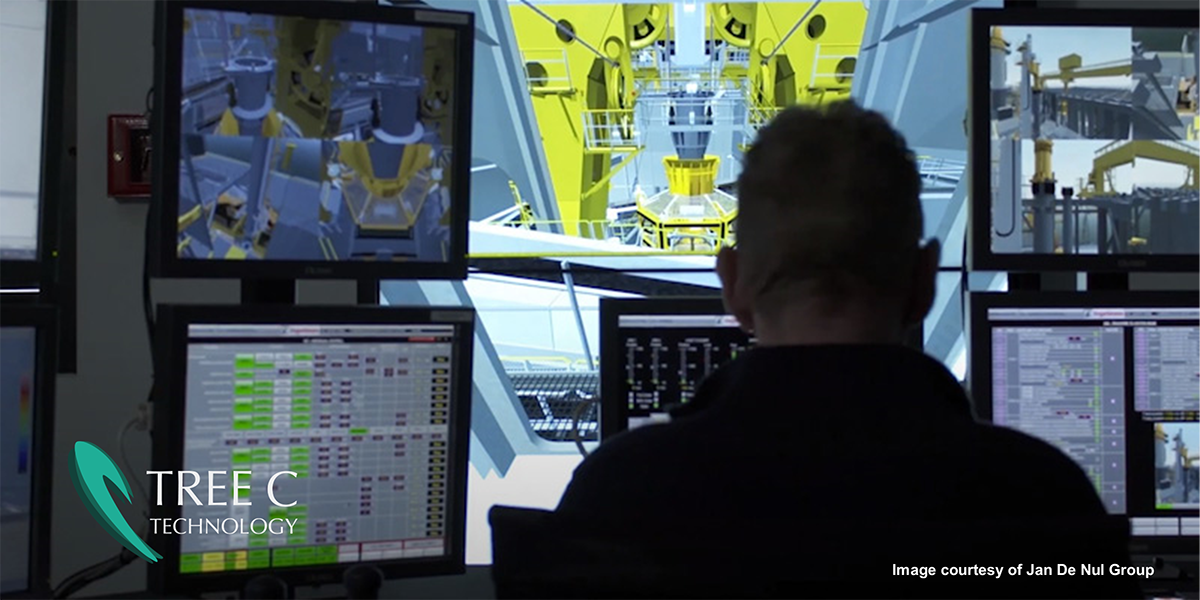How Digital Twins Add Value To Offshore Operations

Due to the remote and unpredictable environment in which they take place, offshore operations have always been a demanding – not to mention expensive – undertaking. From poor visibility to operator training, some of the toughest subsea challenges are being overcome by the innovative use of digital twins.
For over 20 years – long before the term ‘digital twin’ was commonly used – companies engaged in offshore operations have used Tree C’s VR technology to enhance their subsea and remote handling operations. Here’s our guide to what it is, why it’s used, and how it can add value to offshore operations.
What Is A Digital Twin?
A digital twin is a virtual representation of a physical object or system. In the context of offshore equipment operations, it’s a virtual replica of a vessel or subsea asset. The digital twin is created by collecting 3D models, physical properties and data from sensors and other sources to create an interactive model of the physical asset.
Digital twins are used to assist with offshore operations such as dredging, heavy lifting, and the deployment of remotely operated vehicles (ROVs). Typical use cases are found in offshore wind, inspection and maintenance of offshore oil and gas platforms, and subsea pipelines, mostly for training new operators, but also for engineering studies of new equipment and validation of new mission procedures
Tree C’s vision on the use of digital twins goes far beyond the development of a 3D moving piece of equipment. The value of a digital twin for offshore operations can dramatically increase when you add real world data about the equipment itself, the operating environment, and the control systems.
By creating a virtual replica of not just the asset, but also its environment, operators can simulate different operating conditions and scenarios, identify potential issues and risks, and optimize maintenance and repair operations to minimize downtime and maximize efficiency.
Digital twins can also be used to improve safety and reduce risk by providing operators with real-time information about the condition of subsea assets. In situations where there is limited visibility or turbulent conditions, digital twins can provide accurate readings on position, clearances, soil interaction, and forces within a VR environment. We call this VR monitoring.
So when we speak of a ‘digital twin’ we refer to an accurate 3D replica of an asset, controlled by its real-world control system and interacting with the environment. To get an idea of how digital twins work, please see our case study on the training simulator we built for Jan De Nul’s Joseph Plateau.
Why Use Digital Twins In Offshore Operations?
Digital twins provide a number of benefits for offshore operations.
- As we’ve just mentioned, their most obvious advantage is the ability to simulate both equipment and the environment. A digital twin of the offshore environment allows for accurate testing and analysis of equipment and systems. This means that engineers and operators can test equipment using realistic physics, which provides a more realistic representation of how equipment will perform in the real world.
- Another benefit of using digital twins is the ability to connect them to real controls. This means operators can train on a highly accurate virtual representation and simulation of real-world equipment, vessels, and conditions at sea. As there’s no need to train operators at sea and on real equipment, this improves safety and reduces downtime. This saves both time and money.
- Digital twins can also merge sensor data into the simulated environment, providing a more comprehensive view of subsea operations. By combining data from sensors on equipment – such as temperature and pressure readings – with data from the subsea environment, operators can gain a better understanding of how equipment is performing through real-time monitoring of ongoing operations.
- One of the most powerful applications of digital twins is as a de-risking tool for design and operation. By simulating the subsea environment and equipment, engineers and operators can identify potential problems before they occur. This means that problems can be addressed before equipment is deployed, reducing the risk of equipment failure and costly downtime.
Powered by Tree C technology, digital twins can have a powerful impact on offshore operations. Talk to Tree C.